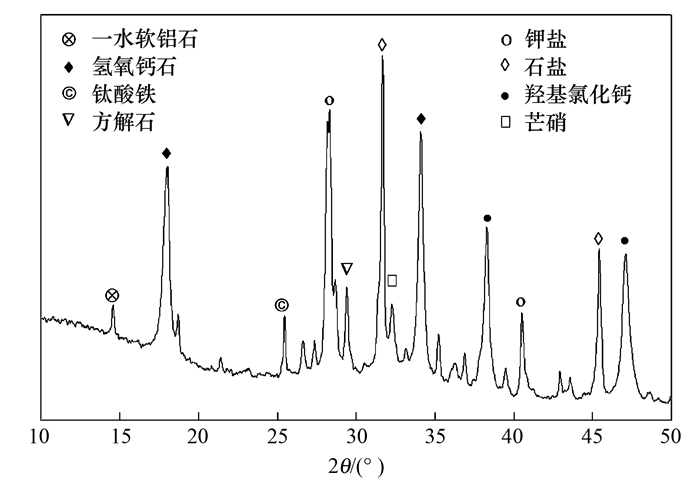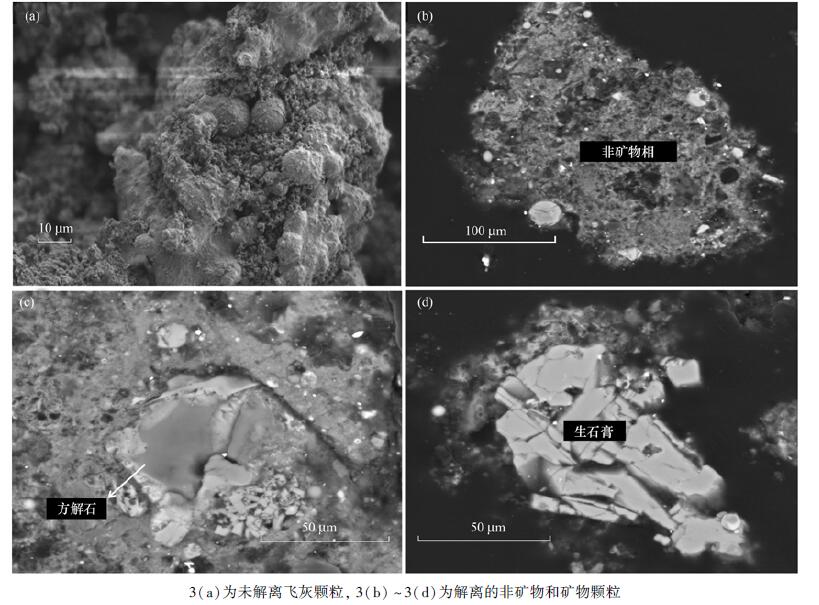生活垃圾焚烧飞灰(“飞灰”)在我国属于危险废弃物, Cu、Cd、Cr及Zn等重金属的浸出毒性引起了人们的广泛关注[1~3].飞灰中的重金属毒性不仅仅与元素的浸出浓度有关, 更与元素的赋存状态密切相关[4].飞灰矿物学特征是重金属赋存环境的直接反映, 准确获取飞灰及处理产物的形貌特征、矿物组成及结合形式、重金属分布状态等矿物学信息是掌握飞灰中重金属释放迁移行为的重要方式.
目前, 关于飞灰矿物学研究的报道已有很多.文献[4~8]通过X射线衍射(X-ray diffraction, XRD)发现飞灰中主要矿物成分包括NaCl、KCl、CaSO4、CaCO3、Ca(OH)2、SiO2等.文献[9, 10]通过SEM观测到飞灰是球形颗粒、多晶聚合体、无定形物质等的凝聚体. Bogush等[5]利用扫描电镜(scanning electron microscope, SEM)-能谱仪(energy dispersive spectrometer, EDS)对不同形貌颗粒进行了成分半定量分析, 发现不同形貌的颗粒对不同种类重金属的富集程度存在很大差异, 并且吸附在颗粒表面的重金属元素存在向颗粒结构内部迁移的行为.文献[11, 12]通过MINTEQA地球化学软件对飞灰中可能的重金属控制矿物相进行了热力学模拟, 发现重金属的浸出行为是矿物控制相发生溶解/沉淀转变的结果.类似的研究还有很多, 但上述研究结论多集中在宏量矿物层面, 难以提供与重金属等微量元素浸出相关的直接证据, 探究飞灰体系微量矿物及重金属富集矿物的详细研究亟待进行.
矿物解离分析系统(mineral liberation analyzer, MLA)是一款基于SEM的自动化矿物参数分析系统, 主要利用矿物背散射电子(back-scattered electrons, BSE)图像灰度值及X射线特征谱线特征对样品矿物参数进行自动定量分析.该程序能够对样品进行全区域扫描并自动统计分析, 最大限度保证测试数据的全面性和准确性. MLA可提供样品图形信息、结构组成、颗粒学参数、矿物相参数及赋存环境、元素分配以及矿物或元素品位与回收率等信息, 已在地质、矿产和冶金行业获得了广泛认可[13~19].其中, 利用MLA技术量化和跟踪微米尺度矿物演变, 分析次生矿物晶相和非晶相发育情况等的相关研究[20~23]对阐述飞灰重金属富集矿物组成、结构及地球化学演变具有重要借鉴意义.
本文结合常规矿物学研究工具及先进的MLA分析系统, 对飞灰颗粒进行矿物种类辨认、矿物含量定量分析以及重金属元素在矿物中的含量和分布状态研究, 通过阐明飞灰矿物学的宏观和微观属性, 以期为飞灰的稳定化处理及重金属环境风险管控提供理论依据.
1 材料与方法 1.1 取样及制样实验飞灰样品来自江苏地区某城市生活垃圾焚烧厂, 该厂为炉排炉工艺, 采用典型的“半干式高速旋转雾化脱酸系统(SDA)+活性炭喷射+半干法Ca(OH)2+袋式除尘器+选择性催化还原法(SCR)脱氮”的烟气净化工艺.通过系统采样法在洗涤塔及布袋除尘器环节进行取样, 飞灰样品采用四分法混匀后于105℃下烘干至恒重, 密封保存.
将样品分为4份, 按相关测试要求研磨至规定细度.分别用作化学元素组成测试、晶体矿物组成测试及微观形貌测试; 最后1份镶嵌在环氧树脂, 抛光、涂炭处理后准备MLA测试.
1.2 测试方法 1.2.1 宏观矿物学属性采用X射线荧光光谱(XRF, Thermo Fisher ARL PERFORM'X, 美国)分析化学元素组成; 采用X射线衍射光谱(XRD, X' Pert Pro PANalytical, 荷兰)分析矿物组成; 采用场发射扫描电子显微镜(SEM, ZEISS MERLIN VP Compact, 德国)分析微观形貌.
1.2.2 微观矿物学属性采用矿物解离分析仪(MLA 650, 美国)自动定量飞灰解离颗粒的矿物学参数.
1.3 MLA测试系统MLA硬件系统配置FEI Quanta多用途扫描电镜和双探头、高能量X射线能谱仪, 软件系统配置MLA配套自动数据采集软件(3.1.4版). MLA测试主要包括图像分析、矿物识别、数据处理等几个步骤.
BSE图像分析又分为颗粒解聚和图像分割两部分[24]. MLA颗粒解聚系统可根据BSE图像颗粒形状参数预判颗粒解离情况, 未完全解离的颗粒进入解聚环节, 通过调整阴影/边界识别、线性特征及侵蚀/扩张操作在分割准则中所占权重, 精确划分颗粒边界[25]. BSE图像分割依据每种矿物确定的灰度值范围进行颗粒识别和裂缝、色差及空洞等造成的伪影修正, 准确勾勒出每种矿物的轮廓.
MLA矿物识别主要基于X射线特征光谱进行分析, 包括X射线单点分析、X射线区域分析以及X射线分布这3种技术[26].该技术可对质量分数高于1%的元素进行定量分析, 当没有重叠峰时, 通过强烈激发特征X射线, 能谱仪可对质量分数0.1%水平的元素进行定量.针对不同测试样品和测试要求, 可选择的测试模式包括标准BSE解离分析(standard BSE liberation analysis, BSE)、扩展BSE解离分析(extended BSE liberation analysis, XBSE)、颗粒X射线分布(particle X-ray mapping, PXMAP)、X射线工艺矿物学分析(X-ray modal analysis, XMOD)以及稀有物相搜寻模式(rare phase search, RPS)等[24].
2 结果与分析 2.1 化学及矿物组成表 1是飞灰样品的元素组成.飞灰主要宏量元素是Ca、Cl、K、Na、S及Si.焚烧垃圾中塑料制品、餐厨垃圾等含Cl组分在焚烧过程中挥发-冷凝, 使得较高含量的Cl主要以可溶氯盐的矿物形式沉积在飞灰表面[27]. Ca则主要来源于烟气净化环节喷入的过量石灰浆, 其剩余部分以及与酸性气体的反应产物赋予了飞灰较高的碱性.
|
|
表 1 飞灰样品元素组成/% Table 1 Elemental composition of MSWI fly ash/% |
图 1是飞灰样品的XRD谱图.可以发现, 飞灰宏量矿物相包括石盐(NaCl)、钾盐(KCl)、氢氧钙石[Ca(OH)2]、羟基氯化钙(CaClOH)等, 还含有少量的芒硝(Na2SO4)、一水软铝石[AlO(OH)]、钛酸铁(Fe2TiO5)等, 与文献[28, 29]结果类似.然而, 高含量的无定形物质会提高XRD图谱背景位置, 遮蔽某些晶体特征峰, 不能很好地反映样品组成中微量矿物[30].
为弥补XRD在微量矿物识别方面的不足, 利用MLA系统BSE模式对飞灰22127个颗粒的矿物组成进行统计, 结果见表 2.从中可知, 飞灰矿物组成大致可分为五大类:非矿物相(14.41%)、碳酸盐类(80.20%)、氧化物类(0.26%)、硫酸盐类(2.08%)及硅酸盐类(3.05%).其中, 含钙碳酸盐矿物含量超过80%, 应是氢氧钙石和羟基氯化钙等矿物组分发生碳酸盐化反应所致.

|
图 1 飞灰样品的XRD谱图 Fig. 1 XRD patterns of MSWI fly ash samples |
|
|
表 2 飞灰矿物组成统计结果 Table 2 Mineral composition statistical results of MSWI fly ash particles |
2.2 微观形貌
图 2是利用MLA系统获取的飞灰颗粒二维扫描图像, 颗粒按面积排列, 矿物以不同颜色区分.从中可知, 飞灰由矿物相和非矿物相组成, 可识别的矿物相主要包括方解石、生石膏、钙长石、硅灰石和赤铁矿, 非矿物相与矿物相之间形成复杂的连生体.未检测到重金属解离颗粒的存在, 可能是重金属含量过低难以成矿或重金属矿物被宏量组分包裹等造成的.

|
图 2 按面积排列的飞灰颗粒 Fig. 2 MSWI fly ash particles arranged by area |
图 3(a)是未解离飞灰颗粒的微观形貌, 图 3(b)~3(d)是MLA系统解离完全的非矿物和矿物颗粒的形貌.由图 3(a)可知, 飞灰中存在大量的无定形物质和少量球形体及絮状物, 整体呈疏松排列, 颗粒与非晶态基体结合在一起, 较难寻找到晶体结构的矿物.图 3(b)显示BSE图像视野中非矿物颗粒颜色偏暗, 粒度在150 μm左右, 结构疏松多孔, 颗粒表面嵌布着不同形状和不同粒度的较亮矿物颗粒.由图 3(c)~3(d)可以看到, 结核状方解石和板状生石膏颗粒粒度在50 μm左右, 表面光滑, 推测为烟气冷凝过程生成的次生矿物.

|
图 3 飞灰颗粒的微观形貌 Fig. 3 Morphology of MSWI fly ash agglomerated and liberated particles |
利用MLA系统分析重金属在飞灰非矿物相和矿物相颗粒中的分布, 结果见表 3.从中可知, 非矿物相是重金属的主要富集相, 其重金属含量表现为Cu>Cr>Zn>Cd.不同种类矿物相对不同重金属存在不同程度的富集作用.以方解石和白云石为主的碳酸盐矿物中分布着Cr、Zn及Cd, 集中了对应的矿物相重金属含量的21.62%、39.12%及70.99%.以赤铁矿为代表的氧化矿物中Cr含量占Cr在矿物相分布含量的78.38%.硅酸盐矿物中Zn和Cd含量较高, 其含量分别占对应的矿物相重金属含量的52.76%和29.02%.重金属在矿物相中的分布模式与Lima等[31]的结果相似.
|
|
表 3 Zn、Cu、Cd和Cr在飞灰中的分布/% Table 3 Distribution of Zn, Cu, Cd and Cr in MSWI fly ash/% |
重金属在非矿物相中分布特征主要与垃圾焚烧过程中重金属的迁移过程密切相关. Cu和Cr为难挥发性金属, 主要以颗粒夹带的形式进入飞灰, 因此绝大部分分布在非矿物组分内. Zn和Cd为半挥发性金属, 具有挥发-冷凝机制, 可与烟气中矿物组分反应次生为重金属富集矿物[32].因此, 飞灰中43.92%的Zn和60.61%的Cd分布在矿物相中.
碳酸盐矿物基本结构单元为[CO3]配位三角形, 易呈孤立岛状与阳离子相连, 同族矿物之间存在广泛类质同象[33~35].阳离子种类不同, 成矿作用形式也存在较大差异. Zn2+可与方解石矿物发生反应生成水锌矿[Zn5(OH)6(CO3)2]沉淀在方解石表面; Cr3+则以碱式碳酸铬(Cr2O3·xH2O·yCO2)的形式罩盖在方解石表面; 吸附在方解石表面的Cd2+能够与晶格中的Ca2+发生离子交换, 形成Cd-CaCO3复合物沉淀[36, 37].
赤铁矿的基本结构单元是由6个O2-和OH-包围铁原子形成的八面体, 晶体中的Fe3+可被Al3+、Cr3+等金属阳离子置换[38].一方面, 赤铁矿的羟基化表面在一定条件下可发生离子化或电离化反应, 对Cr3+或Cr2O72-等离子产生静电吸附作用[39, 40].另一方面, Cr和Fe同属亲铁元素, 离子半径相近, 具有相似的地球化学行为, 赤铁矿结构中的Fe3+可被Cr3+离子同晶置换[41].
硅酸盐结构包括硅氧骨干和硅氧四面体[SiO4]两部分, Si4+位于四面体中心, O2-位于四面体角顶, 电负性差D=1.7, 离子键和共价键各占一半, 四面体之间可角顶相连成三维架状结构[38].当体系pH值>3(石英零电点pHpzc=3.0)时, 石英表面带负电, 由于静电引力与Cd2+发生吸附, 吸附参数可用Freundlich模型进行描述, 其反应动力学可通过扩散层表面络合模型(DLM)进行很好地解释[42, 43].石英与Cd2+通过静电引力生成外圈配合物, 与Zn2+通过共价键或离子键形成内圈配合物[44].虽然石英对Cd2+的吸附量更高, 但吸附Zn2+形成的产物具有更高的稳定性.
3 讨论重金属元素在飞灰中含量极低并具高度分散性, 不易形成独立矿物, 因此难以被XRD、SEM等设备检测到.但MLA结果表明, 重金属元素在飞灰中主要以3种形式存在:均匀分布在无定形的非矿物组分中、以同晶置换赋存在方解石等矿物中以及吸附在特殊矿物如石英、赤铁矿等表面.同晶置换是方解石负载Cr3+、Zn2+和Cu2+的主要形式, 而吸附作用在石英富集Zn2+和Cd2+过程中占据主导地位, 这两种作用在赤铁矿中都有体现.
相似的地球化学性质和地球化学行为是导致重金属发生同晶置换的根本原因. Ca2+、Cr3+、Zn2+和Cu2+的离子半径依次为0.100、0.062、0.074和0.073 nm, 故Cr3+、Zn2+和Cu2+存在与Ca2+发生同晶置换的可能[45].而(碱式)碳酸盐的溶解度顺序: CaCO3>Cr2O3·xH2O·yCO2>Zn5(OH)6CO3>CdCO3, 与表 3中方解石的重金属分布结果一致, 说明方解石对重金属的富集作用受控于碳酸盐的溶解性.
重金属在矿物表面的吸附依赖于矿物的界面性质.氧化物或硅酸盐颗粒表面结合着配位水形成羟基化表面, 界面羟基可以质子化或脱质子化, 从而使颗粒具有两性特征.这些颗粒表面可与金属离子发生吸附, 也可与配体(重金属的含氧酸根)发生置换.反应形式如下[46](式中, S表示表面, M表示金属, L表示配体):

|
(1) |

|
(2) |

|
(3) |

|
(4) |
(1) 飞灰由矿物相和非矿物相组成, 矿物相主要包括NaCl、KCl、Ca(OH)2、CaClOH、CaCO3及CaSO4等, 非矿物相与矿物相之间形成复杂的连生体.
(2) 重金属元素在飞灰中主要以3种形式存在:均匀分布在无定形的非矿物组分中、以同晶置换赋存在方解石等矿物中以及吸附在特殊矿物如石英、赤铁矿等的表面.
(3) 重金属主要分布在非矿物相中, 但矿物相对重金属也有非常重要的富集作用.方解石由于同晶置换对Cd有较强富集作用, 硅酸盐以界面吸附对Zn有较好的固定作用, Cr在赤铁矿中分布是同晶置换和界面吸附的双重作用.
(4) 重金属的挥发性等物化性质和焚烧炉燃烧条件是Cu和Cr等难挥发性元素在非矿物相中富集的原因, 相似的地球化学性质和地球化学行为是导致重金属发生同晶置换的根本原因, 而重金属在矿物表面的吸附则依赖于矿物的界面性质.
| [1] | Zhao Y C, Song L J, Li G J. Chemical stabilization of MSW incinerator fly ashes[J]. Journal of Hazardous Materials, 2002, 95(1-2): 47-63. DOI:10.1016/S0304-3894(02)00002-X |
| [2] | He P J, Zhang H, Zhang C G, et al. Characteristics of air pollution control residues of MSW incineration plant in Shanghai[J]. Journal of Hazardous Materials, 2004, 116(3): 229-237. DOI:10.1016/j.jhazmat.2004.09.009 |
| [3] | Pan Y, Wu Z M, Zhou J Z, et al. Chemical characteristics and risk assessment of typical municipal solid waste incineration (MSWI) fly ash in China[J]. Journal of Hazardous Materials, 2013, 261: 269-276. DOI:10.1016/j.jhazmat.2013.07.038 |
| [4] | Ni P, Li H L, Zhao Y C, et al. Relation between leaching characteristics of heavy metals and physical properties of fly ashes from typical municipal solid waste incinerators[J]. Environmental Technology, 2017, 38(17): 2105-2118. DOI:10.1080/09593330.2016.1246612 |
| [5] | Bogush A, Stegemann J A, Wood I, et al. Element composition and mineralogical characterisation of air pollution control residue from UK energy-from-waste facilities[J]. Waste Management, 2015, 36: 119-129. DOI:10.1016/j.wasman.2014.11.017 |
| [6] | Quina M J, Santos R C, Bordado J C, et al. Characterization of air pollution control residues produced in a municipal solid waste incinerator in Portugal[J]. Journal of Hazardous Materials, 2008, 152(2): 853-869. DOI:10.1016/j.jhazmat.2007.07.055 |
| [7] | Aubert J E, Mahieux P Y, Husson B. Mineralogical transformations during a stabilization process developed for the valorization of municipal solid waste incineration (MSWI) fly ash[J]. Waste and Biomass Valorization, 2010, 1(2): 261-270. DOI:10.1007/s12649-010-9018-6 |
| [8] | Brännvall E, Andreas L, Sjöblom R, et al. Factors influencing chemical and mineralogical changes in RDF fly ashes during aging[J]. Journal of Environmental Engineering, 2014, 140(3). DOI:10.1061/(ASCE)EE.1943-7870.0000802 |
| [9] | Evans J, Williams P T. Heavy metal adsorption onto flyash in waste incineration flue gases[J]. Process Safety and Environmental Protection, 2000, 78(1): 40-46. DOI:10.1205/095758200530439 |
| [10] |
王军, 蒋建国, 隋继超, 等. 垃圾焚烧飞灰基本性质的研究[J]. 环境科学, 2006, 27(11): 2283-2287. Wang J, Jiang J G, Sui J C, et al. Fundamental properties of fly ash from municipal solid waste incineration[J]. Environmental Science, 2006, 27(11): 2283-2287. DOI:10.3321/j.issn:0250-3301.2006.11.026 |
| [11] | Zhang Y, Jiang J G, Chen M Z. MINTEQ modeling for evaluating the leaching behavior of heavy metals in MSWI fly ash[J]. Journal of Environmental Sciences, 2008, 20(11): 1398-1402. DOI:10.1016/S1001-0742(08)62239-1 |
| [12] | Zhang Y, Cetin B, Likos W J, et al. Impacts of pH on leaching potential of elements from MSW incineration fly ash[J]. Fuel, 2016, 184: 815-825. DOI:10.1016/j.fuel.2016.07.089 |
| [13] | Rizmanoski V. The effect of microwave pretreatment on impact breakage of copper ore[J]. Minerals Engineering, 2011, 24(14): 1609-1618. DOI:10.1016/j.mineng.2011.08.017 |
| [14] | Celep O, Serbest V. Characterization of an iron oxy/hydroxide (gossan type) bearing refractory gold and silver ore by diagnostic leaching[J]. Transactions of Nonferrous Metals Society of China, 2015, 25(4): 1286-1297. DOI:10.1016/S1003-6326(15)63725-6 |
| [15] | Lv J F, Zhang H P, Tong X, et al. Innovative methodology for recovering titanium and chromium from a raw ilmenite concentrate by magnetic separation after modifying magnetic properties[J]. Journal of Hazardous Materials, 2017, 325: 251-260. DOI:10.1016/j.jhazmat.2016.11.075 |
| [16] | Reichert M, Gerold C, Fredriksson A, et al. Research of iron ore grinding in a vertical-roller-mill[J]. Minerals Engineering, 2015, 73: 109-115. DOI:10.1016/j.mineng.2014.07.021 |
| [17] | McGladrey A J, Olivo G R, Silva A M, et al. The integration of physical rock properties, mineralogy and geochemistry for the exploration of large zinc silicate deposits:a case study of the Vazante zinc deposits, Minas Gerais, Brazil[J]. Journal of Applied Geophysics, 2017, 136: 400-416. DOI:10.1016/j.jappgeo.2016.11.013 |
| [18] | Parker T, Shi F N, Evans C, et al. The effects of electrical comminution on the mineral liberation and surface chemistry of a porphyry copper ore[J]. Minerals Engineering, 2015, 82: 101-106. DOI:10.1016/j.mineng.2015.03.019 |
| [19] | Tsikouras B, Pe-Piper G, Piper D J W, et al. Varietal heavy mineral analysis of sediment provenance, Lower Cretaceous Scotian Basin, eastern Canada[J]. Sedimentary Geology, 2011, 237(3-4): 150-165. DOI:10.1016/j.sedgeo.2011.02.011 |
| [20] | Redwan M, Rammlmair D, Meima J A. Application of mineral liberation analysis in studying micro-sedimentological structures within sulfide mine tailings and their effect on hardpan formation[J]. Science of the Total Environment, 2012, 414: 480-493. DOI:10.1016/j.scitotenv.2011.10.038 |
| [21] | de Andrade Lima L R P, Bernardez L A. Characterization of the soil contamination around the former primary lead smelter at Santo Amaro, Bahia, Brazil[EB/OL]. https: //doi.org/10.1007/s12665-017-6791-6, 2017-7-10. |
| [22] | Redwan M, Rammlmair D, Nikonow W. Application of quantitative mineralogy on the neutralization-acid potential calculations within μm-scale stratified mine tailings[EB/OL]. https: //doi.org/10.1007/s12665-016-6344-4, 2016-12-31. |
| [23] | Zhang P Y, Guo Q, Wei G Y, et al. Leaching metals from saprolitic laterite ore using a ferric chloride solution[J]. Journal of Cleaner Production, 2016, 112: 3531-3539. DOI:10.1016/j.jclepro.2015.10.134 |
| [24] | Gu Y. Automated scanning electron microscope based mineral liberation analysis an introduction to JKMRC/FEI mineral liberation Analyser[J]. Journal of Minerals & Materials Characterization & Engineering, 2003, 2(1): 33-41. |
| [25] | Leißner T, Hoang D H, Rudolph M, et al. A mineral liberation study of grain boundary fracture based on measurements of the surface exposure after milling[J]. International Journal of Mineral Processing, 2016, 156: 3-13. DOI:10.1016/j.minpro.2016.08.014 |
| [26] | Fandrich R, Gu Y, Burrows D, et al. Modern SEM-based mineral liberation analysis[J]. International Journal of Mineral Processing, 2007, 84(1-4): 310-320. DOI:10.1016/j.minpro.2006.07.018 |
| [27] |
朱芬芬, 高冈昌辉, 大下和徹, 等. 焚烧飞灰预处理工艺及其无机氯盐的行为研究[J]. 环境科学, 2013, 34(6): 2473-2478. Zhu F F, Masaki T, Kazuyuki O, et al. Pretreatment technology for fly ash from mswi and the corresponding study of chloride behavior[J]. Environmental Science, 2013, 34(6): 2473-2478. |
| [28] |
王春峰, 陈冠飞, 朱艳臣, 等. 不同粒径垃圾焚烧飞灰重金属毒性浸出及生物可给性[J]. 环境科学, 2016, 37(12): 4891-4898. Wang C F, Chen G F, Zhu Y C, et al. Leaching toxicity and bioaccessibility of heavy metals in mswi fly ash with various particle sizes[J]. Environmental Science, 2016, 37(12): 4891-4898. |
| [29] |
章骅, 于思源, 邵立明, 等. 烟气净化工艺和焚烧炉类型对生活垃圾焚烧飞灰性质的影响[J]. 环境科学, 2018, 39(1): 467-476. Zhang H, Yu S Y, Shao L M, et al. Influence of air pollution control (APC) systems and furnace type on the characteristics of apc residues from municipal solid waste incinerators[J]. Environmental Science, 2018, 39(1): 467-476. |
| [30] | van Alphen C. Automated mineralogical analysis of coal and ash products-challenges and requirements[J]. Minerals Engineering, 2007, 20(5): 496-505. DOI:10.1016/j.mineng.2006.12.013 |
| [31] | Lima A T, Ottosen L M, Pedersen A J, et al. Characterization of fly ash from bio and municipal waste[J]. Biomass and Bioenergy, 2008, 32(3): 277-282. DOI:10.1016/j.biombioe.2007.09.005 |
| [32] |
张海龙, 李祥平, 陈永亨, 等. 垃圾焚烧过程中重金属分布迁移机理和控制技术[J]. 安徽农业科学, 2013, 41(4): 1699-1703, 1715. Zhang H L, Li X P, Chen Y H, et al. Heavy metals distribution, migration characteristic and control technique during municipal solid waste incineration process[J]. Journal of Anhui Agricultural Sciences, 2013, 41(4): 1699-1703, 1715. DOI:10.3969/j.issn.0517-6611.2013.04.112 |
| [33] | Lenders J J M, Dey A, Bomans P H H, et al. High-magnesian calcite mesocrystals:a coordination chemistry approach[J]. Journal of The American Chemical Society, 2012, 134(2): 1367-1373. DOI:10.1021/ja210791p |
| [34] | Finch A A, Allison N. Coordination of Sr and Mg in calcite and aragonite[J]. Mineralogical Magazine, 2007, 71(5): 539-552. DOI:10.1180/minmag.2007.071.5.539 |
| [35] | Heberling F, Trainor T P, Lützenkirchen J, et al. Structure and reactivity of the calcite-water interface[J]. Journal of Colloid and Interface Science, 2011, 354(2): 843-857. DOI:10.1016/j.jcis.2010.10.047 |
| [36] | Ahmed I A M, Crout N M J, Young S D. Kinetics of Cd sorption, desorption and fixation by calcite:a long-term radiotracer study[J]. Geochimica et Cosmochimica Acta, 2008, 72(6): 1498-1512. DOI:10.1016/j.gca.2008.01.014 |
| [37] | García-Sánchez A, álvarez-Ayuso E. Sorption of Zn, Cd and Cr on calcite. application to purification[J]. Minerals Engineering, 2002, 15(7): 539-547. DOI:10.1016/S0892-6875(02)00072-9 |
| [38] | 李胜荣. 结晶学与矿物学[M]. 北京: 地质出版社, 2008. |
| [39] |
石书柳, 吴丽梅, 廖立兵. 赤铁矿对模拟污水中重金属铬(Ⅵ)离子的吸附及固定化[J]. 化工进展, 2013, 32(8): 1949-1954, 1959. Shi S L, Wu L M, Liao L B. Adsorption and fixation of chromium(Ⅵ) ion from simulated wastewater on hematite[J]. Chemical Industry and Engineering Progress, 2013, 32(8): 1949-1954, 1959. |
| [40] |
王强, 屈亚非, 肖广全, 等. α-Fe2O3对Cr(Ⅲ)的等温吸附特征研究[J]. 土壤学报, 2010, 47(1): 159-162. Wang Q, Qu Y F, Xiao G Q, et al. Characteristic of isothermal adsorption of Cr(Ⅲ) on hematite surface[J]. Acta Pedologica Sinica, 2010, 47(1): 159-162. |
| [41] |
唐黎, 李秋华, 陈椽, 等. 贵州普定水库沉积物重金属分布及污染特征[J]. 中国环境科学, 2017, 37(12): 4710-4721. Tang L, Li Q H, Chen C, et al. Distribution and pollution characteristics of heavy metals in sediments of Puding Reservoir, Guizhou Province[J]. China Environmental Science, 2017, 37(12): 4710-4721. DOI:10.3969/j.issn.1000-6923.2017.12.037 |
| [42] | Aşçi Y, Nurbaş M, Saǧ A Y. Investigation of sorption/desorption equilibria of heavy metal ions on/from quartz using rhamnolipid biosurfactant[J]. Journal of Environmental Management, 2009, 91(3): 724-731. |
| [43] | Schaller M S, Koretsky C M, Lund T J, et al. Surface complexation modeling of Cd (Ⅱ) adsorption on mixtures of hydrous ferric oxide, quartz and kaolinite[J]. Journal of Colloid and Interface Science, 2009, 339(2): 302-309. DOI:10.1016/j.jcis.2009.07.053 |
| [44] | Nelson J, Wasylenki L, Bargar J R, et al. Effects of surface structural disorder and surface coverage on isotopic fractionation during Zn(Ⅱ) adsorption onto quartz and amorphous silica surfaces[J]. Geochimica et Cosmochimica Acta, 2017, 215: 354-376. DOI:10.1016/j.gca.2017.08.003 |
| [45] | Chirenje T, Ma L Q, Lu L P. Retention of Cd, Cu, Pb and Zn by wood ash, lime and fume dust[J]. Water, Air, & Soil Pollution, 2006, 171(1-4): 301-314. |
| [46] | 马伟. 固水界面化学与吸附技术[M]. 北京: 冶金工业出版社, 2011. |
 2018, Vol. 39
2018, Vol. 39


